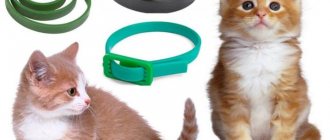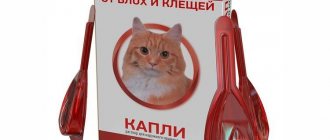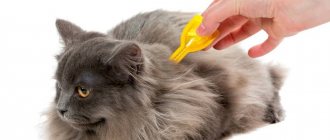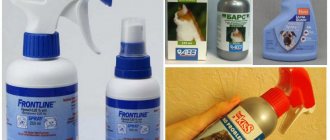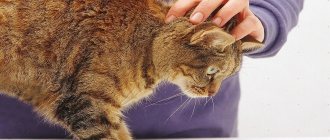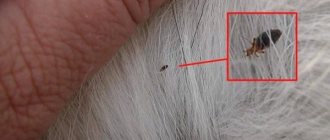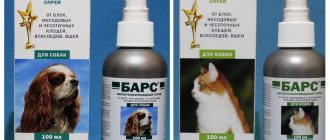Science knows more than 2.5 thousand mallophages that parasitize poultry. In chickens, lice eaters and feather eaters are most often found. They not only cause discomfort, disrupt the structure of the plumage and skin, but also carry dangerous viral diseases (encephalitis, salmonellosis, brucellosis, plague and others). Chicken mites bite, including people, causing severe allergies, irritations, and dermatitis. It is much more difficult to get rid of mallophages when there is a mass infection of the livestock than to cure single individuals.
Composition and release form
Forms of release of the drug:
- Celandine Maximum flea drops are a yellowish oily liquid packaged in 1 ml polymer pipettes. They are packed in cardboard boxes of 1–5 pieces. The main active ingredients included in the drops are fipronil and permethrin. Excipients: polyvinylpyrrolidone, propylene glycol, dimethyl sulfoxide.
- Spray Celandine. Available in bottles of 100, 150 and 200 ml. When applying the product to an animal’s fur, the spray is sprayed at a distance of 15–20 cm. Since the pet can be poisoned when licking the substance, it must be limited in movement until the end of treatment. Within 10 days, infection with ectoparasites is completely excluded.
Release form
- Zoosprey Celandine Maximum. The main components of the product are fipronil and pyriproxyfen. It goes on sale in 100 ml bottles. Can be used to kill fleas, ixodid ticks and treat sarcoptic mange. In the first case, treatment is carried out every month, and in the second - once a week.
- Zoo shampoo Celandine. The main active ingredient is permethrin. Available in bottles of 100, 150, 180 and 200 ml. Used for bathing animals to destroy ectoparasites. Treatment is carried out every 15 days.
- Shampoo Celandine Maximum. The main component is permethrin. Produced in bottles of 180 and 250 ml. After treatment, the product must be thoroughly rinsed off to prevent the animal from licking it. The frequency of use is determined by the veterinarian.
- Collar Celandine. The active ingredient is permethrin. Can be used for cats and dogs. It is a narrow tape made of polymer. Can only be used for animals that have reached the age of 4 months. The effectiveness of the collar depends on the type of ectoparasite against which it is used - ixodid ticks (3 months), fleas (4 months). Products are prohibited for use on pregnant and lactating pets.
- Collar Celandine Maximum . Products with lengths of 40, 50 and 65 cm are available for sale. Indications and contraindications are similar to the product of the Celandine brand.
- Collar Celandine Plus. The main component is diazinon. On sale you can find products with lengths of 35, 40 and 65 cm.
- Powder "Clandestine". A powdery substance whose active ingredient is permethrin. Packaged in packages of 50 and 100 mg. When processing, the powder must be applied in a thin layer and rubbed into the animal’s fur. After this, the pet should be combed with a comb.
For reference! Spray Celandine against fleas can be used when treating premises.
Operating principle
The drug Celandine helps get rid of fleas, ixodid and ear mites in cats and dogs, destroys lice and nits. The main components of the product have the same effect on different forms of blood-sucking insects.
Shampoo application
The action of the drug is based on blocking electrical movements in synapses, which provokes paralysis and death of blood-sucking insects. All parasites are destroyed within two days.
The insecticidal components of the drug accumulate on the outer layer of the epithelium and wool. Thanks to this, the protective properties of the drops are maintained for 4–8 weeks. During this period, insects that accidentally fall on the animal’s fur die.
Since the components of the drug are not absorbed into the systemic circulation, the risk of side effects is minimal. The exception is situations in which the pet licks the medicine.
Methods for getting rid of fleas at home
Methods for getting rid of fleas are divided into 2 categories - veterinary drugs/products and folk remedies. As practice shows, the use of one procedure in a number of situations does not help to get rid of fleas forever; therefore, complex therapy is required, which includes, in addition to treatment, preventive measures.
Flea spray and drops
Flea sprays are modern insecticidal products that are safe for cats. Used inside an apartment or house, observing safety precautions (ventilation of the room, use of rubber gloves, etc.).
Modern flea sprays contain several components - a classic insecticide that destroys adult fleas and a repellent that repels insects, reducing the risk of repeated flea infestations.
The product is applied to the entire skin and fur of the animal by spraying, excluding the mucous membranes, genitals, ears, eyes and mouth. Immediately after use, it is necessary to monitor your pet for some time so that it does not lick off the liquid that has not yet dried.
Preparations:
- Bolfo. Insecticide based on propoxur. Destroys adults and larvae. Retains insecticidal properties for 2 weeks after use. In rare cases, it causes allergic reactions if the pet has an individual intolerance to permethrin or its derivatives. Suitable for cats over 12 weeks of age;
- Vet's Best. A complex herbal preparation containing mint oil, eugenol, sodium lauryl sulfate and a number of excipients. Destroys fleas at any stage of development, including eggs and larvae of parasites. The effect after use lasts for 1 week. It has no general contraindications and is used for kittens older than 3 weeks;
- Hartz. Universal insecticide based on tetrachlorvinphos. Destroys all types of ectoparasites (including fleas, ticks, lice eaters), has a repellent effect for one and a half weeks after use.
An alternative option for treating animal skin against fleas is drops. They are applied exclusively to the skin in the area of the cat’s withers and spine. The active ingredient in most drip preparations is a repellent that repels ectoparasites for up to 6 weeks after use. Veterinarians recommend combining both types of products.
Typical preparations: Canina Petvital Verminex, Bars, Inspector, Beaphar.
Shampoo and soap
This group of products belongs to insecticide preparations that have a lower (compared to sprays and drops) concentration of the active substance and pleasant aromatic fragrances.
Thanks to the balanced formula, the use of shampoos and soaps does not require additional safety measures (gloves, respirator). Immediately after the washing and drying procedure, the animal is released to walk around the apartment.
As practice shows, insecticidal shampoo and soap are less effective in comparison with spray and drops, therefore they are used as an addition to complex therapy for flea infestations. Typical preparations: Ms Kiss, Celandine, Trixie, Priroda Lux, Adverso, Rolf Club, BioVax.
Flea collars
Most often, flea collars are recommended for cats that regularly walk outside. The products are a small strip of material impregnated with several active substances. It is placed around the animal's neck and worn on an ongoing basis.
The vast majority of flea collars contain several active ingredients - insecticides and repellents (usually deltamethrin and pyriproxyfen). Moreover, the concentration of the former is insignificant due to moderate toxicity with long-term use.
Constantly wearing the product for animals on walks gives a good preventive effect in preventing re-infection with parasites, including ticks, fleas, and lice eaters for 3-6 months. Collars have 2 disadvantages:
- Smell. Animal-safe insecticides with which the products are impregnated emit a weak but rather unpleasant odor. If sprays, shampoos and other types of anti-flea products are used once and their smell disappears, then the collar is worn for quite a long time, which creates discomfort for both the person and the pet;
- Local irritation. The collar sometimes rubs the animal’s neck, causing local baldness, inflammation in the area of direct contact, and causes severe discomfort to the cat in the summer.
Flea and tick powder Celandine
Celandine flea and tick powder was developed and produced in Russia specifically for animals. Customers who tried the product were satisfied with the result.
The active ingredient in the powder is permethrin. Concentration – 0.5%.
Release form: container with dispenser.
The amount of powder used is calculated according to the weight of the animal. You cannot use more than 500 mg of powder per 1 kg of pet.
Improper use of the product will harm animals and humans. Rules to be followed:
- Before the procedure, wear gloves and protect your face with a respirator;
- the animal’s skin should be free of scratches, wounds and other damage;
- the animal's fur must be dry;
- During pregnancy and lactation, the use of powder is not recommended; in extreme cases, consult a veterinarian;
- Do not use powder during illness or in the near future after it - there is a high risk of intoxication;
- After finishing the procedure, wash your hands and face thoroughly with soap.
It is forbidden to apply powder to animals under two months of age. For a fragile body, the composition of the powder can be harmful.
It is required to strictly follow the rules prescribed in the instructions:
- the animal and the person must be in a spacious, ventilated room or outdoors;
- a thin layer of the substance is applied to the animal’s fur;
- gently rub in the powder, moving your hands against the growth of the fur;
- do not treat the area near the ears, eyes, mouth and nose - getting powder into sensitive areas is dangerous to health;
- After finishing the treatment, the animal should not be stroked or touched for 14-15 hours, so as not to shake off some of the substance;
- if the pet had few ticks or fleas, then one application of powder will be enough;
- In case of severe pest infestation, the procedure must be repeated after a week.
Celandine powder is assigned category 3 - this means that when used according to the instructions, the insecticide will not cause harm to health.
It is recommended to apply powder not only to your pet, but also to the places where he spends time: carpets, bedding, floors in the house.
Owners who used Celandine noted quick relief from ticks and fleas, as well as excellent protection against pests while walking in the forest.
Celandine powder will destroy insects that torment your pet and protect against future attacks by parasites.
Folk remedies against fleas
Before using any of the folk remedies listed below, you must consult a veterinarian. In some cases, the use of certain procedures can be potentially dangerous for a pet.
- Essential oils. Used as repellents to repel blood-sucking insects. Apply after applying insecticides. Typical options: extracts of rosemary, geranium, cedar, lavender. To create a working fluid, you need to dilute 10 drops of the product in one glass of water, then use a spray bottle to evenly distribute it over the coat and skin, avoiding spraying on the mucous membranes, genitals, ears and eyes;
- Garlic tincture. An ancient Russian remedy designed to kill and repel fleas. 1 medium-sized head of garlic is peeled and divided into cloves. The latter are crushed into a pulp and filled with 1 liter of water at room temperature. The container with the product is placed under a nylon lid for 12 hours. Garlic tincture should be strained through 2 layers of gauze, then dripped onto the withers and in the area of the cat’s spine;
- Forbs. It is necessary to take 10 grams of eucalyptus, lavender, wormwood and tansy in equal proportions, then pour the collection with 1 liter of boiling water and place in a water bath. The product is removed from the heat after 20 minutes and infused for half an hour. The resulting liquid is filtered through several layers of gauze and rubbed into the animal's skin.
Instructions for use for cats and dogs
Before starting to treat the animal, it is necessary to calculate the dosage. In this case, it is necessary to know the age and weight of the pet. For example, when treating cats, kittens and puppies, different numbers of drops of Celandine are needed. You also need to take into account the dosage form of the drug, since the features of the drug’s use depend on this.
Algorithm for applying Celandine drops to destroy blood-sucking insects and prevent their appearance:
- Break off or cut off the top of the medicine dropper.
- Gently part the animal's fur at the withers.
- Apply the product to the epithelium, avoiding places that the pet can lick.
Celandine flea spray is suitable for treating animal premises and bedding, but before allowing your pet near treated surfaces, you must wait until the insecticidal solution has dried.
To achieve greater effectiveness from the use of the drug, it is necessary to take into account some recommendations:
- If the medicinal solution is used to kill parasites, the treatment is carried out once. When the goal is to treat notoedrosis and sarcoptic mange, manipulations are repeated 2–4 times every 8–10 days.
- To prevent infection by ticks and fleas, the treatment is repeated every 2 months.
- In the first 24 hours, do not allow moisture to get on your pet's fur. Water reduces the effectiveness of the drug.
- Treatment must be systematically repeated to maintain the therapeutic effectiveness of the product.
Drops on the withers
If the drug is used to treat otodectosis, you need to clean the ears from dirt and drop 1-3 drops of the product into each ear canal. To completely cure the parasites, repeat the steps after 5 days.
CElandine universal antiparasitic powder (100 g)
Anti-parasitic powder CHISTOTEL is a highly effective and safe drug.
Suitable for treating premises and animal habitats.
CHISTOTEL is a series of drugs and cosmetics created for a wide range of pet owners by Ecoprom, which has been operating in the veterinary market for more than 17 years. During this time, the company has come a long way from a small production facility to a modern research and production complex, but the main operating principles have remained unchanged - reliability and responsibility.
Constant communication with pet owners and cooperation with the country's leading veterinary clinics, thorough clinical trials of each drug, understanding of how important it is for veterinary drugs to be effective and safe - this is why, when creating drugs, the Ecoprom company uses the most modern developments and formulations in the field of veterinary medicine, allowing the creation of highly effective drugs that meet the highest safety standards.
Composition and release form:
Permethrin – 0.4%, ground soapstone.
They are produced ready for use, packaged in bottles with a capacity of 100 g.
Pharmacological properties:
A universal remedy for controlling insects (fleas, lice, lice and feather eaters) and ticks on domestic animals and birds.
Indications for use:
Celandine powder is used to destroy ixodid ticks, fleas, lice, lice parasitic on dogs and cats, guinea pigs, rats and other ornamental rodents, as well as down-eaters (with mallophagosis) of ornamental birds.
Doses and method of administration:
Treatment should be carried out outdoors or in a ventilated area. The entire body of the animal is subject to treatment. Apply a thin layer of powder to the skin and hair at the rate of 500 mg (1 press per bottle) per 1 kg of animal weight, rub lightly against the growth of the hair, avoiding contact with the eyes. If necessary, the procedure should be repeated 1-2 times with an interval of 7-10 days.
More details: see instructions inside the package.
Side effects:
There are no side effects or complications when using Celandine in accordance with these instructions. The use of the drug does not exclude the use of other medications. If complications are detected in animals after using the drug, its use is stopped.
Contraindications:
Do not apply to damaged animal skin, avoid contact with eyes and mucous membranes. Not recommended for sick individuals, animals younger than 2 months, pregnant and lactating females.
Storage conditions:
In a dry place, protected from light and out of reach of children and animals, away from heating appliances. Separated from food and feed at temperatures from 0C to 30C.
The shelf life of the drug, subject to storage conditions in closed packaging, is 36 months from the date of manufacture.
Country of origin: Russia.
Information about the composition and ingredients, color scheme, technical and other characteristics, country of origin, appearance and delivery package of the product is for reference only and is based on the latest information available at the time of publication. Delivery of this product is carried out to all regions of the Russian Federation.
Dosage of the drug
If Celandine is used against fleas for cats, then when treating pets weighing up to two kg, use ½ pipette, for animals with a larger body weight - the whole pipette.
For puppies and small breed dogs, the dosage is taken similarly to cats ; the dose for large breed dogs is calculated using the formula - 1 pipette for every 10 kg of weight.
If you plan to treat a pet's room or bedding, the amount of product used is calculated using the formula - 2 ml per 1 m2 of room. When spraying the spray, the dosage is 0.5 ml over a similar area.
Routes of infection
Mallophages spread from wild (or infected) birds, from dirty bedding and equipment.
Increase the risk of infection:
- unsanitary conditions, high humidity in poultry houses;
- large crowding of individuals;
- poor nutrition;
- lack of free range.
Rodents that enter chicken coops are also carriers. Sometimes parasites are brought in by owners on shoes, food, and care items.
Contraindications and possible side effects
According to the instructions for use, the restrictions for the use of Celandine drops against fleas and ticks are:
- animal weight less than 500 g;
- the period of bearing and feeding offspring;
- age up to two months;
- weakness and exhaustion.
The drug should be used with caution in animals with renal or hepatic insufficiency. Before processing, you should consult a specialist.
Possible side effects:
- increased salivation;
- systematic release of tear fluid;
- indigestion;
- itching or hyperemia of the skin in the treatment area;
- apathy;
- lack of appetite.
To prevent the development of negative consequences, you must adhere to some rules:
- If you plan to treat several animals at once, you should prevent them from licking each other. It is better to lock your pets in different rooms.
- The combined use of different forms of insecticidal agents - collars, powder, etc. is prohibited.
Side effects and contraindications
Animals that are sick or recovering cannot be treated with the product because their body is in a weakened state. In addition, the drug should not be used for puppies whose age does not exceed three months, or if there is an intolerance to any component of the drug or an infectious pathology.
During pregnancy, the animal can use powder only after consultation with a specialist.
When used correctly, there are no side effects.
Precautionary measures
Celandine is considered a rather dangerous product because it contains components that can cause poisoning. To avoid intoxication, you should follow some recommendations:
- Before you start using the drug, you must wear rubber gloves.
- On the first day, it is better to avoid direct contact with your pet. You should also limit children’s contact with animals for 2–3 days.
- When carrying out manipulations, a person should stop smoking, drinking food and liquids. This will help prevent the drug from entering the body.
- After contact with the medicinal solution, hands should be washed with soap under running water and treated with an antiseptic.
- After processing, pipettes should be discarded.
Hand washing
Advantages and disadvantages
Advantages of using Celandine for cats and dogs:
- large selection of different release forms;
- simple dosage calculation;
- high efficiency in destroying parasites of various types;
- long action;
- low price;
- no problems with purchasing.
Minuses:
- the risk of developing allergies in an animal or person;
- high toxicity;
- a large number of contraindications and restrictions based on body weight and age.
Signs of fleas, ticks and lice in chickens
Symptoms of infection increase gradually; in the initial stages it is quite difficult to notice the problem. As the parasites multiply, the following signs of damage appear:
- nervousness;
- plucking your own feathers;
- lethargy;
- traces of pecking, wounds on the skin;
- cough;
- loss of appetite, weight loss;
- irritation;
- sleep disorders;
- serous discharge from the eyes;
- decreased egg production;
- growth retardation in chickens;
- baldness;
- damage to the bases of the feather rods.
Chickens are reluctant to return to the poultry house in the evenings and stop using their usual nesting sites. In the worst case scenario, the young animals begin to die.
Some parasites can be noticed during examination of the bird. Ticks are often visible on the paws and other exposed areas of the body. Lice and fleas hide under the wings, near the anus, on the neck.
